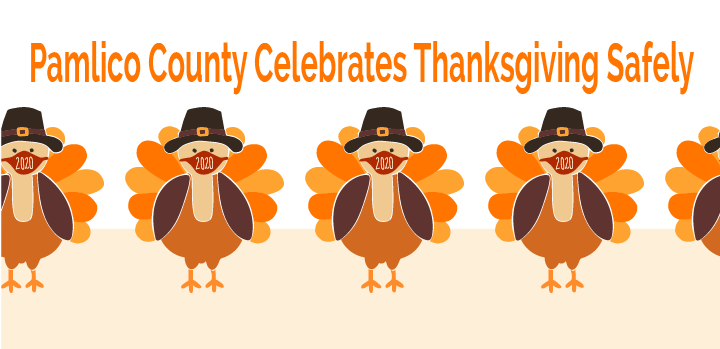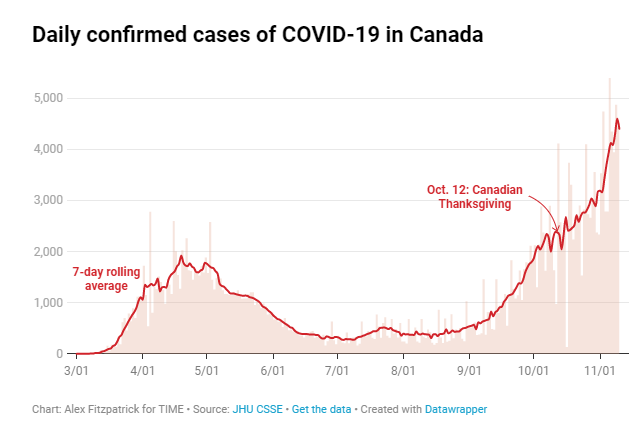
The North Carolina Department of Health and Human Services (NCDHHS) released guidance for celebrating the upcoming Thanksgiving holiday, and we are sharing this guidance with you. Canadians celebrate Thanksgiving in October, and they learned the hard way that family gatherings can be fuel for the spread of the COVID-19 virus. While Canada was already on an upward trajectory for COVID-19 even before Thanksgiving, several Canadian experts said that the holiday almost definitely made things even worse.

Interim Guidance for the Thanksgiving Holiday
(November 12, 2020)
Any scenario in which many people gather together poses a risk for COVID-19 transmission. This guidance is intended for people celebrating Thanksgiving outlining lower and moderate risk activities, as well as the higher risk activities that should be avoided to keep our communities safe. While the holidays are a time when families and others gather together, you should be careful, particularly if gatherings include individuals at higher risk for severe illness (e.g., people over the age of 65 or who have underlying health conditions), and if there is an increasing or high number of cases in the community. If you have been recently diagnosed with COVID-19, have symptoms of COVID-19, or have been around a person with COVID-19, then do not host or participate in any in-person gatherings until you complete your isolation or quarantine period.
Decreasing risk during the holidays:
- The best way to reduce your risk of viral transmission is to limit travel during the holidays and limit physical contact with people who do not live in your household.
- You should practice the 3W’s and wear a face covering, keep 6 feet of social distancing, wash hands well. The 3Ws are even more important if you are getting together with someone at high risk of complications with COVID-19.
Travel and gathering during the holidays:
If you are traveling and/or are planning to be with family members you do not live with during the holidays, there are steps you should take to reduce the risk of viral spread.
- You should consider having a screening COVID-19 test prior to travel or attending family gatherings. If you do have a screening test, consider the following important information:
o A negative test only gives you information for that point in time. A negative test does not mean you will remain negative at any time point after that test.
o Screening tests may miss some infections, particularly if done using rapid or “point of care” tests.
o Even if you have a negative test, you should wear a mask, physically distance, avoid crowds and indoor crowded places, wash your hands frequently, monitor yourself for symptoms, and minimize contact with people at high risk of complications of COVID-19.
If you are planning in-person holiday gatherings with people outside of your household:
Before the event:
- You should consider asking all guests to strictly avoid contact with people outside of their households for 14 days before the gathering.
- Remind invited guests to stay home if they have been exposed to COVID-19 in the last 14 days or are showing COVID-19 symptoms.
- Clean and disinfect commonly touched surfaces (e.g., door handles, sink handles, bathroom surfaces) before guests come over and between uses.
- Keep the guest list small. When deciding how many people to invite to your gathering, consider the amount of space you have and the ability to maintain social distancing during the event.
- Higher risk guests should consider attending events virtually, so they can remain safely at home.
- If higher risk individuals do attend gatherings in person, ensure the 3Ws are practiced by all guests and limit the number of other guests in attendance as much as possible.
- The day before the event, all guests should screen for symptoms and stay home if they are not feeling well.
During the Thanksgiving event:
- Host your gathering outdoors, when possible. If this is not feasible, make sure the room or space is well-ventilated by opening windows and doors to the extent that is safe and feasible based on the weather.
- Arrange tables and chairs to allow for social distancing between guest. People from the same household can be in groups together and do not need to be 6 feet apart – just 6 feet away from other groups or families.
- Practice the 3 Ws (Wear, Wait, Wash) during the event: Wear a face covering when not eating or drinking, Wait six feet apart from others, and Wash your hands regularly.
- o When guests need to remove a face covering to eat or drink, it is recommended they maintain 6 feet distance from people outside their household and put their face coverings back on after they are done eating or drinking.
- Limit people going in and out of the areas where food is being prepared or handled, such as in the kitchen or around the grill, if possible. Have one household approach the food serving area at a time to prevent congregating.
- Consider identifying one person to serve all food so that multiple people are not handling the serving utensils.
- Use single-use options or identify one person to serve sharable items, like salad dressings, food containers, and condiments, so that multiple people are not handling the items.
For more recommendations on how to safely attend a gathering, please follow the NCDHHS Guidance for Private Social Gatherings and Guidelines for Get-Togethers and only engage in the lower or moderate risk activities below.
|
Lower Risk Activities |
|
|
Moderate Risk Activities |
|
|
Higher Risk Activities |
|
Additional Resources
- NC DHHS: North Carolina COVID-19
- CDC: Interim Guidance for Businesses and Employers
- CDC: Cleaning and Disinfecting Your Facility
- CDC: Reopening Guidance
- EPA: Disinfectants for Use Against SARS-CoV-2
- FDA: Food Safety and the Coronavirus Disease 2019 (COVID-19)
- HHS/OSHA: Guidance on Preparing Workplaces for COVID-19
